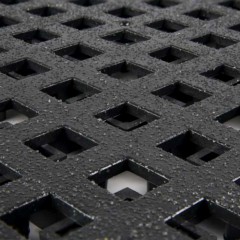Options for Perforated Floor Tiles
When you want flooring that’s perfect to use in a wet area with standing water, perforated floor tiles from Greatmats are the best choice. Unlike some cheap perforated raised floor tiles, our models carry the perforated holes and slots through the entire thickness of the tile. Even with holes in them, they work well for heavy-duty industrial applications, as they can support weight without breaking down.
Types of Perforated Floor Tiles
You can select our perforated flooring in pre-cut mats or smaller interlock tiles. The mats simplify covering a specific space, such as in front of a restaurant dishwashing station, while the tiles let you create a customized coverage space. Either format works for temporary or semi-permanent installations.
Three different waterproof materials are available in our perforated floor tiles, including:
- PVC plastic is lightweight and flexible, but it’s far more durable than you may think.
- Perforated rubber flooring delivers a highly durable material and creates excellent traction in wet conditions.
- Hard plastic can support significant amounts of weight, making it ideal for use as perforated garage floor tiles.
Features and Benefits of Drainage Floor Tiles
Some of the primary features and benefits of our drainage floor tiles include:
- The perforations extend through the entire thickness of the tile.
- A raised base allows water to flow underneath and reach the floor drain.
- Many models of these tiles can be used indoors or outdoors.
- Different sizes of tiles and mats are available for different use cases.
- Different sizes of perforations are available to adjust the drainage speed.
- Interlocking tiles and pre-cut mats are easy to install.
- Cleaning and maintenance are easy because they’re made for use in tough conditions.
Where to Use Perforated Floor Tiles
One of the best things about our drainage floor tiles is the multiple different locations where you can use them. They’re extremely versatile and can stand up to almost any kind of liquid or chemical. The locations where you can use these tiles include:
Perforated Floor Tiles Q&A
Where can I use interlocking drainage floor tiles?
You can
use interlocking drainage floor tiles in multiple locations, including patios, pool decks, athletic courts, or similar outdoor spaces. They also work for indoor spaces, like basements, showers, locker rooms, industrial areas, and similar locations.
What are the pros and cons of vented garage floor tiles?
Some of the
pros of using vented garage floor tiles are that they allow water and oil to drain through, they provide traction in wet areas, and they allow in-floor heat systems to operate as normal. Some cons of using vented garage floor tiles include allowing debris to fall through the slots, potentially requiring periodic disassembly of the tiles to clean underneath them.
What are the best drainage tiles for home use?
The
best drainage tiles for home use include our
Perforated Garage Tile, our
StayLock Perforated Basement Tile, and our
Patio Outdoor Tile. These products can withstand difficult weather conditions, offer excellent durability, and are easy to install.
Where do you use drainage cell tiles?
Places you can
use drainage cell tiles include rooftop patios, inside garage areas, near landscaping, and along walking paths. You also could use them indoors in kitchens, bakeries, machine shops, and shipping centers.
What is the best mechanical room flooring?
The
best mechanical room flooring will protect the subfloor from chemical spills, abrasion, impacts, and excessive weight. These flooring options provide protection against unwanted moisture or significant vibrations, too.










